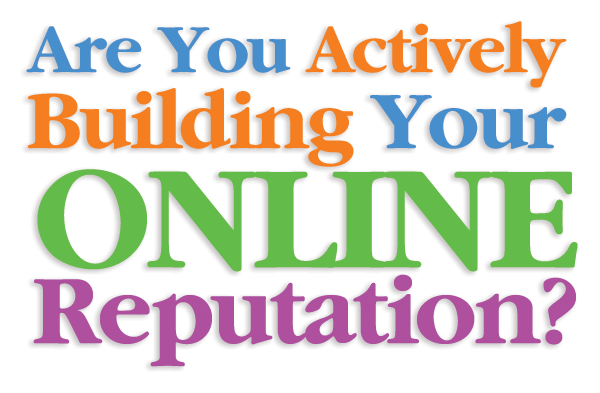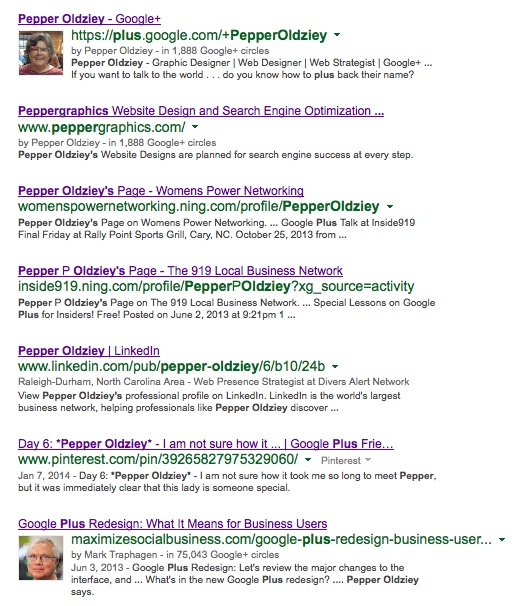Are You Actively Building Your ONLINE Reputation?

By Pepper Oldziey, based entirely on the work of David Amerland in Chapter Four of his new book, Google Semantic Search
How do you trust?
We are talking about trust. Trust online. Trust offline. How do you build trust in a person? How do you build trust in a business? You do something to interact with them. You try them out. If you are with them and can see them, you have many signals to use to determine if they are honest or trustworthy. If you are dealing with a business, you shop there, and if your experience is good and the product is good, then it works out well. Trust is based on direct experience.
What if you have no direct experience with the person or with the business you seek to trust? What are the signals you check out? Usually it is something or someone that validates their reputation for you. You trust a third party to suggest or recommend someone. (Think of a blind date here.) Sometimes it is not a very accurate system. For a store online, you might check them out on any number of online websites. How many recommendations do they have? What about social media "likes" . . . are they an accurate trust recommendation?
Google, or another search engine, is the usual third party trust system. Does the business show up in search? Where? How does Google know where to put them and do those people on the first page really deserve your trust? Fancy websites grabbed our attention with sleek, well-designed, fancy details and interaction. Then we learned that they were often gaming the system.
For a business website to rank high in search, it used to need validation from other entities online. If one business valued another, they often linked to it. Then people started gaming the links, buying and selling them. Websites that ranked high on search could as easily buy their way to first page instead of earning it.
In a world where life was based on a small community, trust was easier. But now we have an algorithm-based software online determining who and what to trust. It is machine driven. How do you prove to Google, to an impersonal machine, that you are worthy of trust?
How do you prove you are worthy of trust?
"The Web is more a social creation than a technical one. I designed it for a social effect—to help people work together—and not as a technical toy. The ultimate goal of the Web is to support and improve our weblike existence in the world. We clump into families, associations, and companies. We develop trust across the miles and distrust around the corner." From, In Weaving the Web: The Original Design and Ultimate Destiny of the WorldWide Web, by Tim Berners-Lee.
The web was intended for social trust. With anonymity, fake profiles and fake pictures, how do you deal with anyone's real online identity? EBay has a trust feedback system that is earned. A buyer or seller could lose their reputation if they violated trust. The mutual reciprocal interaction made it important to maintain trust. How do you translate this from purchases to the exchange of ideas? What is the motivation for honesty there? Facebook has shared that it has 83 million fake profiles. You can't even trust a face.
"Page Rank," named after Larry Page one of the founders of Google, would indicate the trust and authority of a website on a particular topic. It assigned a numerical value to each website. The order was a major factor determining who came first in search.
This order was based on who linked to you and how much authority they had. They defined your rank. Ideally people would get to know you or your company and link to you. All the gaming schemes of fake links based on keywords ruined that.
Trust is based on your identity. Your relationships are important. Your web content quality is important. Identity, relationships and content are the real trust factors. But how do we get back to real?
Google has developed a new trust system, Google+. Google saw the spamming of its own online recommendation system, obtained a patent years ago and developed a new online way to build trust. It is Google+. You can create an online identity with real trust. It is a voluntary effort to be honest that can bring you real gain.
How does a computer algorithm judge your reputation?
People author content online. It is by your content that you are judged. Content can be stolen. People use scraper tools to gain content on a given topic from around the web and republish it. Ideally it is attributed to its real author. Sometimes it is not. How does Google know?
How does Google judge the identity of a content creator?
Who you are
What else you have created
Your social media connections
Your online activity
Your interactions with other people
How people receive your content
Content quality authority and originality
Content presentation from headlines to footnotes
But how does it know this is really you?
That is the function of Google+. It is a voluntary identity validation system. This is why people use it. They want Google to know what is their content so they can be judged fairly and ranked correctly in search so people can find them. It is a simple, clear concept, and Google has developed a system to do it that is not worth gaming. It takes a while to build up a reputation online, and only a few wrong actions to lose it. This is why people come to Google+.
Do you have Google authorship and trust?

Your real picture, a face not a brand logo, identifies you for Google. One identity only for you, with anything connected to you connected to it. Once Google knows you and has verified that you are a real person, then it can reliably identify your work and position it correctly. Yes, it is a nuisance to bother with this. But, when your work is associated with your picture in search, you are now a validated recommendation that can be trusted. That is the point. Is it worth it to you? Think about that.
Authorship Steps
1. You need to use a good clear face photograph of you.
2. You set up a Google+ profile (not a page) and place your photo there.
3. You verify to Google that you are the person in that image.
4. You put a link in the "About" page contributor section to websites on which you author content.
5. Put a backlink from those websites to your Google+ profile, a two-way link using a Google+ badge.
It is not difficult to do this for yourself. If you are willing, then your photo will soon show up on some search results with your content. People relate to a human face. Human relationships build and give you a chance to earn the trust and reputation of your audience.
Now what does Google do for you? Your photo can show up with your content in search, and not just for people who are logged into Google. This is public. You build your reputation as Google connects other content you have authored to you. If you go to search and read a post by an author with a photo, and you go spend a bit of time long enough to read that page or article, and then you come back to search, you are likely to see more posts by the same author selected for you. Google promotes the people it knows. Simple idea, isn't it?
It takes time. Google is a learning machine. It can make mistakes and sometimes mix up people and their work. But it learns the correction and does not forget it, so we have a growing learning system that builds on what it knows and expands its connections. It scales well with complexity. Can this system be gamed by the dishonest? It takes too much time to build reputation in this system to be worth gaming it. It is a system that rewards honesty.
David Amerland explains, "One of the benefits of the semantic web seems to be that the transparency of connections between authors, content creators, content curators, and websites is making us all a bit more honest."
What do you do if you are a small business?
You can't just be showing one photo and one profile page for a business. That would not make sense unless you are a sole-proprietor who owns his or her business. Instead, this Google+ system allows a business to leverage the identities of its people to increase the value and importance of the business. They all have profiles and these are all connected to the business page and site.
The ranking of a website is based on its association with its authors, its content creators. This is a radically different system than anything that came before. Businesses were trusted based on their branding, their expensive websites and their advertising. Now they will be ranked on the search engine, based on the quality of their content and the reputation of their content creators. This is no longer just about your marketing department or your PR people.
How would you prepare a business for this type of search engine ranking?
1. Identify key staff with a "good online reputation as authors" to represent your company.
2. Plan the way you will leverage your company personnel to promote your website online.
3. Organize your staff to speak with one voice representing your company online.
4. Educate each staff member on "authorship" and help them to set up a Google+ profile that links to the company website.
5. Assist these staff members to blog and become involved, to be active in the process of their own online presence and, in turn, valuable to your business in this way.
6. Help the staff learn how to judge their own effectiveness online, for themselves and for the company. Identify the tools and/or measures to be used.
7. Plan how your company reputation will be connected to and closely linked to the people who work in it.
8. Plan for your company to make good use of its amplified digital presence.
Are you ready for this level of transparency online? Visualize the benefit to your company and its customers. This high quality reputation development can be of great benefit to your company visibility in search and the trust relationship you have with your customers. It will take a while to build, but those who make the investment will reap the rewards.
Does your company have the courage and the trust in the high quality reputation of its people to do this?
Thank you to David Amerland for providing us with a rich model of this new web opportunity of semantic search. His book formed the inspiration for this article based on Chapter Four and each of the articles based on Chapter One, Chapter Two, and Chapter Three, with the added Landscaper Story. You can purchase his book, Google Semantic Search, and read all about it in full detail for yourself.

